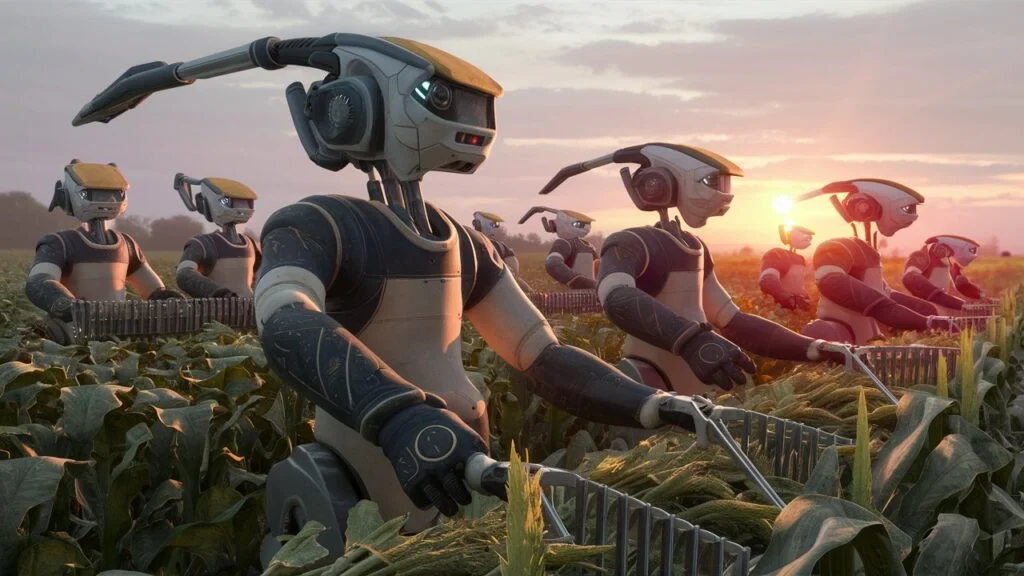In recent years, there has been a significant shift towards automation in various industries, including agriculture. With the advancement of technology, robots are increasingly being employed to perform tasks traditionally carried out by humans. In the realm of farming, the use of robotics has revolutionized the way crops are planted, monitored, and harvested.

Robotic Harvesting Revolution: Agrobots Transform Fields!
The concept of using robots for harvesting dates back several decades. Early attempts at robotic harvesting were rudimentary and often impractical. However, with advancements in robotics, artificial intelligence, and machine learning, harvesting robots have become more sophisticated and capable of handling a wide range of crops.
Benefits of using robots for harvesting
The adoption of robotic harvesting offers numerous benefits to farmers and agricultural producers. One of the primary advantages is the increased efficiency that robots bring to the harvesting process. Unlike human labor, robots can work tirelessly without fatigue, leading to higher productivity levels.
Additionally, robotic harvesting is often more cost-effective in the long run. While the initial investment in robotic equipment may be substantial, the reduced reliance on human labor and the potential for increased yields can result in significant savings over time.
Furthermore, robotic harvesting reduces dependency on seasonal labor, which can be unreliable and costly. By automating the harvesting process, farmers can mitigate the risks associated with labor shortages and fluctuations in labor costs.
Challenges faced by robotic harvesting
Despite the numerous benefits, robotic harvesting also presents several challenges. One of the primary obstacles is the technical limitations of current robotic systems. While robots are proficient at performing repetitive tasks in controlled environments, they may struggle to adapt to the variability and unpredictability of agricultural settings.
Another challenge is the adaptability of robotic harvesting solutions to different crops. Each crop has its own unique characteristics and harvesting requirements, making it challenging to develop one-size-fits-all robotic systems.
Additionally, the initial investment costs associated with adopting robotic harvesting technology can be prohibitive for some farmers, particularly those operating on a smaller scale or in developing regions.
Current status of robotic harvesting
Despite these challenges, robotic harvesting technology has made significant strides in recent years. Industries such as fruit and vegetable farming, vineyards, and greenhouses have embraced robotic solutions to improve efficiency and productivity.
Case studies and success stories abound, showcasing the tangible benefits of robotic harvesting in real-world agricultural settings. From automated fruit picking to precision harvesting of delicate crops, robots are proving to be valuable assets to farmers around the world.

Future prospects and trends
Looking ahead, the future of robotic harvesting appears promising. Innovations in robotics, artificial intelligence, and sensor technology continue to drive advancements in the field. From autonomous drones for crop monitoring to robotic arms equipped with computer vision for selective harvesting, the possibilities are endless.
The widespread adoption of robotic harvesting has the potential to revolutionize the agriculture industry, increasing productivity, reducing labor costs, and improving sustainability. As technology continues to evolve, we can expect to see even greater integration of robotics into every stage of the farming process.
Conclusion
In conclusion, robots are indeed taking over harvest season, transforming the way crops are harvested and revolutionizing the agriculture industry. While challenges remain, the benefits of robotic harvesting are undeniable. As technology continues to advance, we can expect to see even greater adoption of robotic solutions in agriculture, leading to increased efficiency, productivity, and sustainability.
FAQs
Can small-scale farmers benefit from robotic solutions?
Yes, small-scale farmers can benefit from robotic solutions, particularly as technology becomes more affordable and accessible. Robotic harvesting can help small-scale farmers improve efficiency, reduce labor costs, and compete more effectively in the market.
What are the main barriers to widespread adoption of robotic harvesting?
The main barriers to widespread adoption include technical limitations, initial investment costs, and the need for specialized training and maintenance. Additionally, regulatory and logistical challenges may also hinder adoption in some regions.
How do robots ensure precision during harvesting?
Robots utilize various technologies, such as computer vision, GPS, and sensors, to ensure precision during harvesting. These technologies enable robots to identify ripe crops, navigate through fields, and execute precise harvesting actions.
Are there any environmental benefits to robotic harvesting?
Yes, robotic harvesting can have environmental benefits, such as reducing the need for chemical inputs and minimizing soil compaction. Additionally, robots can optimize harvesting practices to minimize waste and promote sustainability.
What crops can be harvested by robots?
Robots are capable of harvesting a wide range of crops, including fruits, vegetables, grains, and nuts. However, the specific crops that can be harvested depend on the design and capabilities of the robotic system.
